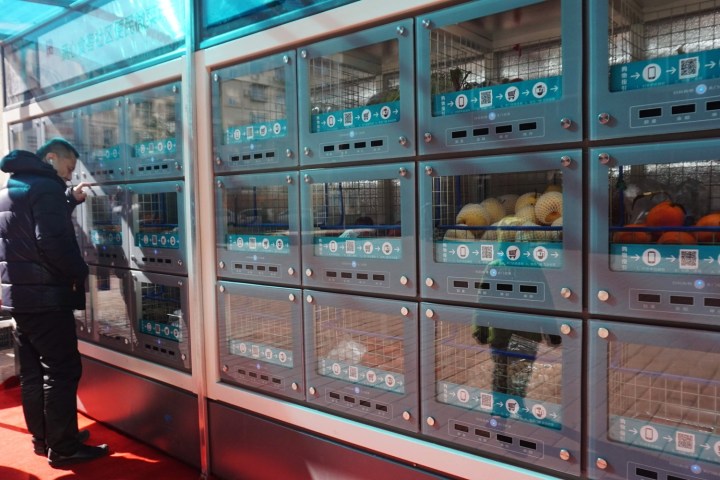
A man walks up to a vending machine in a Shenzhen subway station to grab a bite. But instead of a can of soda or bag of chips, his options are far more exotic. Yes, the basic snack items are available, but so are pastries, tofu, and chicken feet — a delicacy in Chinese cuisine. If he wants more variety, another machine offers fresh food items that include cooked noodles, prepared eggs, fresh vegetables, and french fries diced from potatoes. To wash it all down, he can grab freshly squeezed orange juice or fresh coconut water poured from a real coconut.
Forget newspapers and pop. In China, vending machines are full-service convenience stores.
“Before, customer demand was simple: they just wanted water, cola,” said Larry Song, a sales manager at the Thintop Technology Company, a Shenzhen-based manufacturer of vending machines, digital signage, and other commercial products. “But now they buy all kinds of things.”
”Customer demand was simple: they just wanted water, cola. But now they buy all kinds of things.”
While the goods are varied, the idea remains the same as with vending machines of the past: put some money into the machine, and out comes the product. But what’s different is the vending machines themselves — they are smart and sophisticated. Modern, energy efficient machines are network connected, which enables operators to monitor inventory. Sensors track foot traffic and consumers’ buying patterns based on time of day, day of week, and corresponding weather conditions.
They are also more social. Customer engagement is enhanced by interactive audio, video, and touchscreen functions. Based on demand, prices are adjusted remotely in real-time. And via apps, frequent shoppers earn free drinks and other rewards.
“The technology is becoming more mature,” Song said. Founded a decade ago, Thintop, which employs more than 100 people, makes these smart vending machines for clients in the U.S., U.K., Canada, France, and Romania, in addition to its home market.

But what’s notable is the payment method — indicative of the shifting habits of the Chinese, from cash to digital. Paying is seamless: Machines only need to accommodate the two top mobile wallets, Alipay and WeChat Pay.
“There is no need to take cash, we just use our cell phone,” Song said. In the U.S., because there is no dominant mobile payment system, machines there must still accommodate cash and credit cards.
Ease of payment will increase as manufacturers continue improving biometric capabilities such as fingerprint, facial, and voice recognition. KFC in China is experimenting with facial recognition technology that customers use when paying for their orders. Similar technologies are migrating to vending machines.
Jeff Orr, research director at ABI Research, said technology changes the buying experience. When sampling beauty products, for example, smart vending machines will take the customer’s picture and then virtually apply various makeup and color combinations to the person’s face.

“You want to be able to have a closer relationship between the brand and end-user,” Orr said.
Smart vending machines also exist outside mainland China. In Taiwan, on Taipei’s historic Dihua Street, tourists can buy engraved chopsticks from a vending machine. In Chinese, Japanese, or English, customers select materials for the handle – wood or plastic. They type in words to be engraved, which can be translated into other languages when produced. Three minutes and $6.60 later, customized chopsticks are dispensed.
And of course, there’s Japan, where smart vending machines have long existed and has been at the forefront of building some of the world’s most unique and advanced vending machines. Like in China, Japanese vending machines are also going cashless and incorporating interactive displays and other smart features.
While smart vending machines aren’t as prevalent stateside, they exist. Swyft is one company that creates hardware and software for “automated retail stores” that incorporate artificial intelligence that not only monitor stock, but can also collect data on how users shop. Those Best Buy kiosks you see at airports? They’re made by Swyft.
Vending is no longer just for goods, it also addresses service needs. Orr said this is “re-envisioning the vending machine, what it carries, and what its purpose is.” For example, 3D printers could make it possible to vend customizable products such as stuffed animals, jewelry, trinkets, and placards. Customers will select colors, styles, sizes, components, and quality. Ready-to-eat foods will also be tailored toward individual customers, who select ingredients and portion sizes.
“That could shape the future of vending,” Orr said.
According to Orr, corporations could also use vending machines to simplify mundane, repetitive IT and inventory management tasks inside their offices. Traditionally, an employee needing a new phone charger, computer cable, or mouse has to file a procurement request via telephone call or email. The IT staffer then responds to the request, logs it into the system, signs out the part, and delivers it. It’s a time-consuming process. Automated vending kiosks, however, could reduce the number of steps involved while also preventing office theft.
This re-establishes the value of IT departments. “It allows them to deal with higher human capital opportunities and needs rather than be a parts depot,” Orr said.
Cashing in on a $12 billion industry
By 2025, the global intelligent vending machine market is forecast to hit $12 billion. Orr said countries adopting next-generation machines are ones that have infrastructure that supports Internet of Things and are “connecting lots of disparate machines to a new network.”
Beyond the standard subway stations, bus depots, and waiting rooms, vending machines are popping up in more schools, airports, shopping malls, office buildings, apartment complexes, and outdoor areas.
Growth is projected to be particularly strong in China, where the GDP per capita is slightly above $8,000. Industry analysts expect demand to increase once it hits $10,000. China has one machine for every 7,600 persons. Compare that to the U.K., which has roughly one vending machine for every 142 persons; the U.S., which has one for every 45; and Japan, which has one for every 23.
Of course, China has a population that’s nearly three-times of the U.S., U.K., and Japan combined. Additionally, the Chinese have embraced on-demand services for umbrellas, sporting goods, phone accessories, and other electronics – all are suited toward vending distribution. With these stats, it’s easy to see why vending machines are a lucrative business in China.
[We’re seeing the] revitalization of the vending machine market.
And venture capitalists are seizing on the opportunities. In September, Blue Lake Capital, GGV Capital, Yunqi Partners, and Zhen Fund participated in a $15 million series-A funding round in Citybox, a Chinese vending machine operator backed by Alibaba. In recent years, Horizon Ventures and Carlyle also invested in the space.
In the eleventh century, the Chinese invented a coin-operated pencil vending machine. During the ensuing millennium, the industry hardly evolved. Today, though, manufacturers, startups, retail conglomerates, and investors are changing that.
“The market is still early, [but we’re seeing the] revitalization of the vending machine market,” Orr said.


